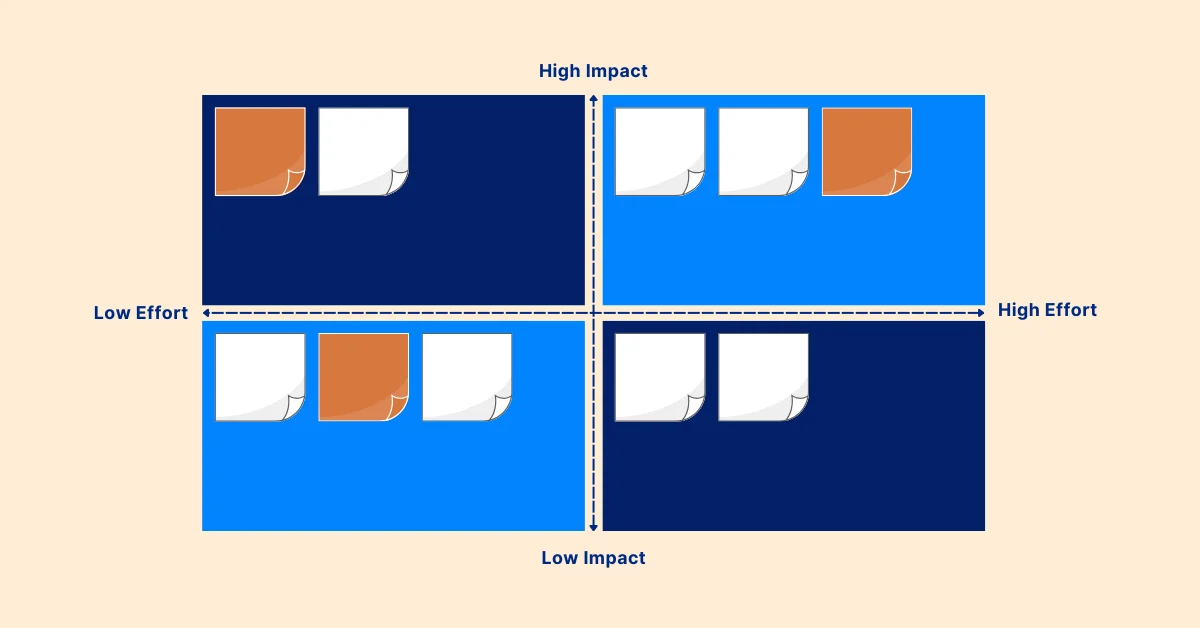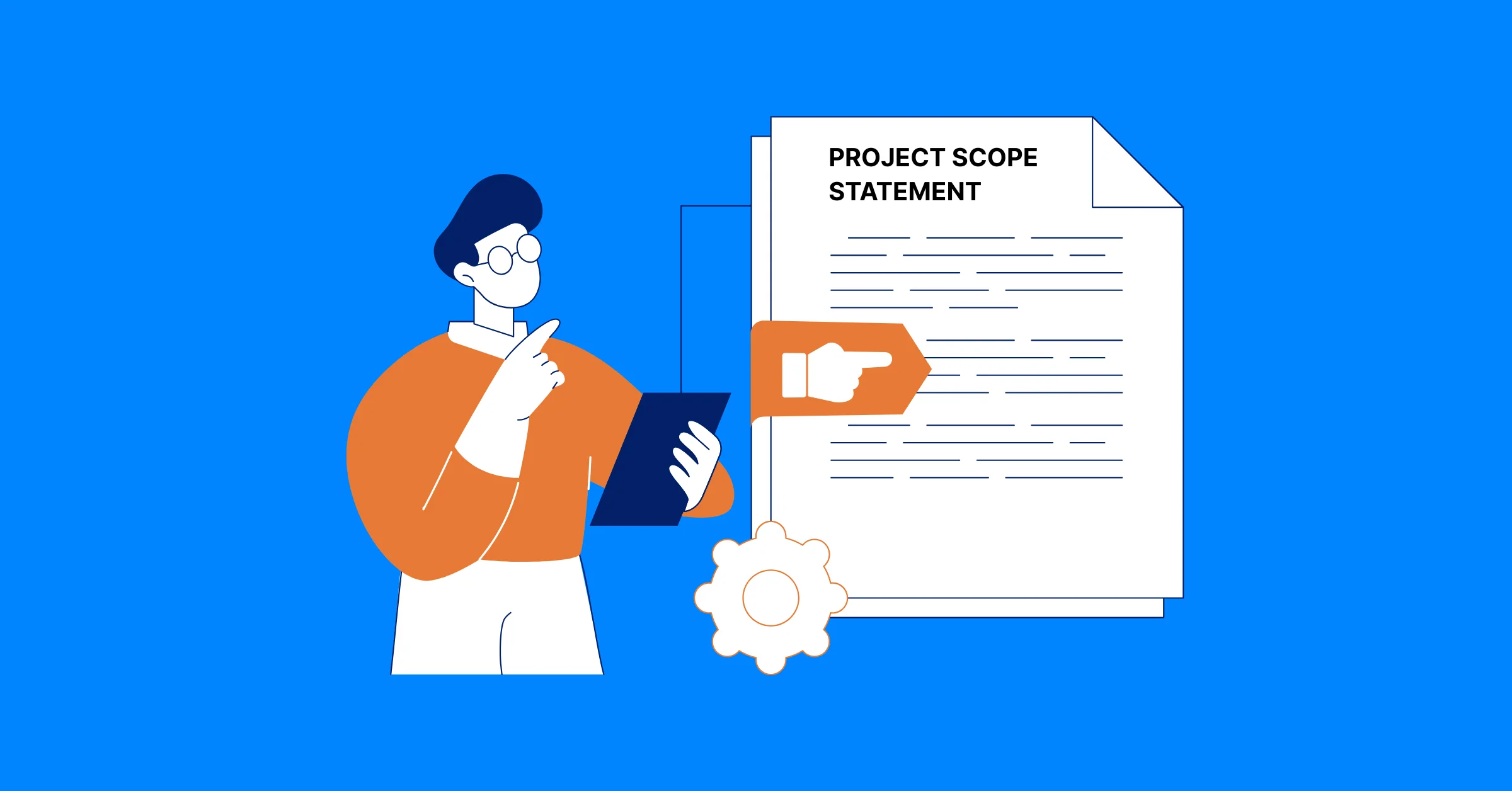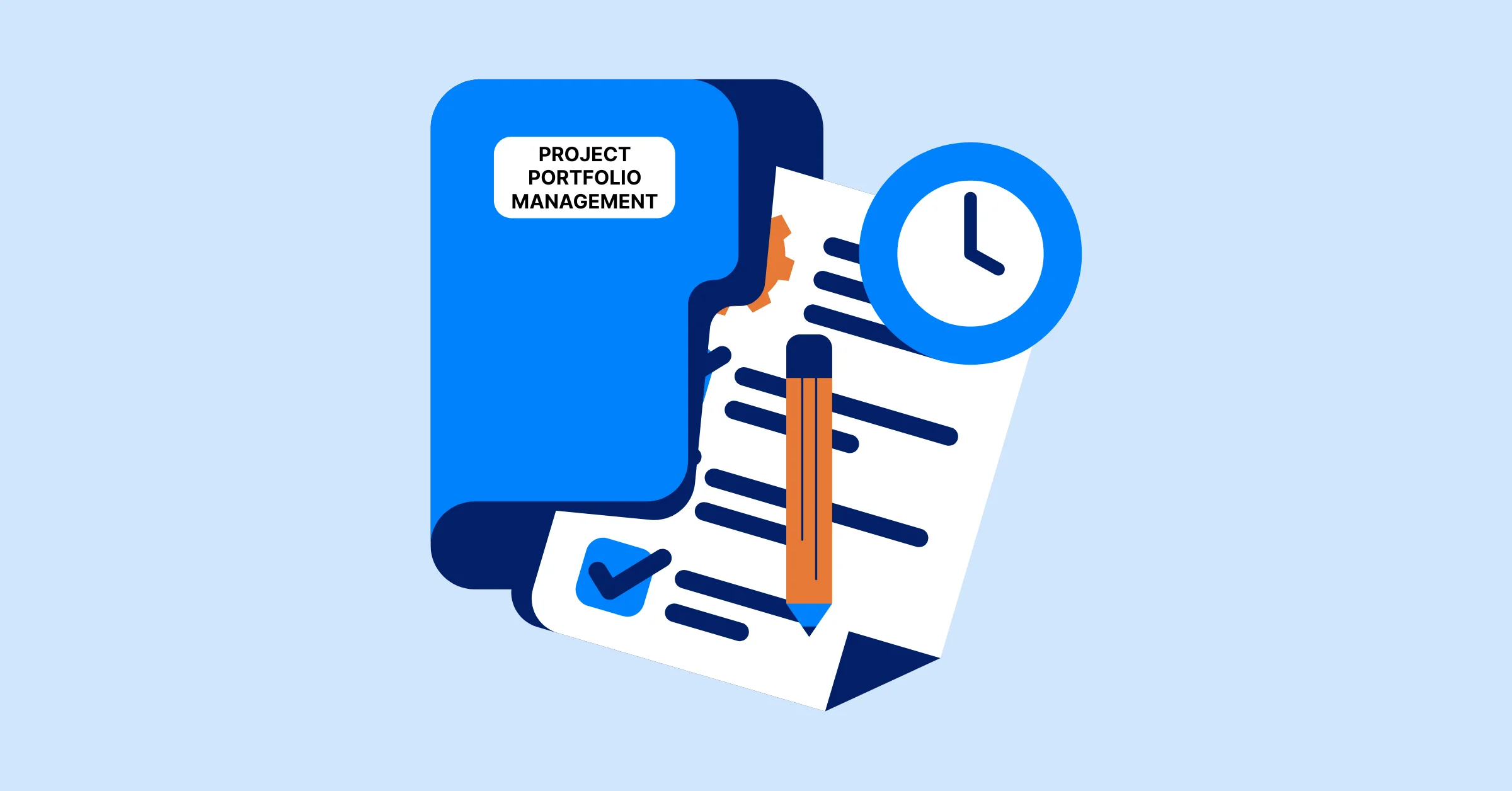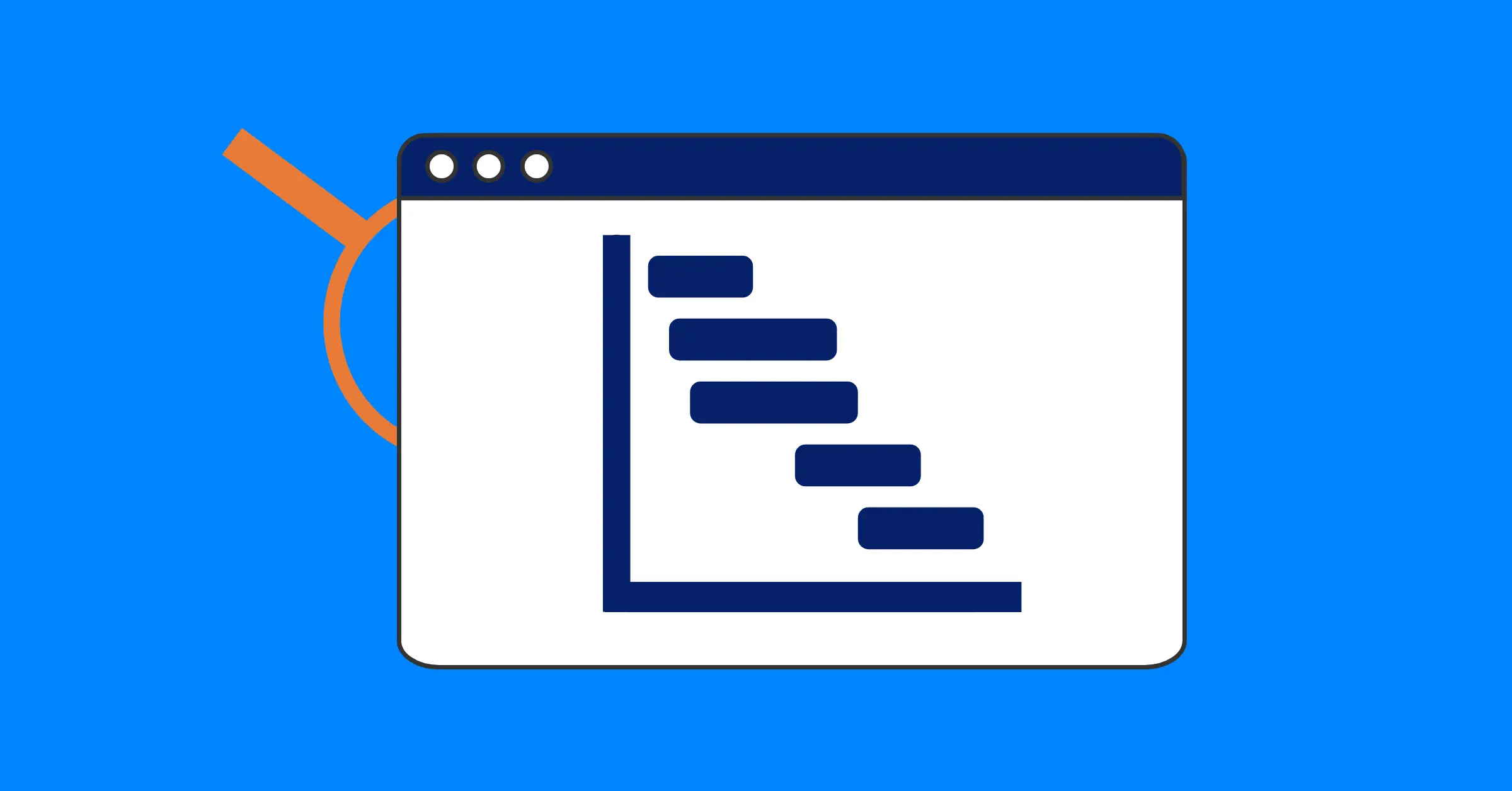7 Common Types of Risk in Project Management Every Manager Should Know
Explores 7 frequent risks in project management, offers practical examples, and shares actionable strategies to manage them, helping you keep your projects on track.
Project management involves navigating uncertainty to deliver successful outcomes. Risks - potential events that can derail a project - are a reality every manager must face. Understanding the common types of risks in project management is the first step to identifying, assessing, and mitigating them effectively. This article explores seven frequent risks, offers practical examples, and shares actionable strategies to manage them, helping you keep your projects on track.
By addressing these risks proactively, you can minimize disruptions and improve project outcomes. Whether you’re managing a construction project, a software rollout, or a marketing campaign, these insights apply across industries. Let’s dive into the seven common types of risks every project manager should know.
What Are Project Management Risks?
Before exploring specific risks, it’s helpful to understand what risks mean in the context of project management. Risks are uncertain events or conditions that, if they occur, can impact a project’s objectives, such as scope, budget, timeline, or quality.
Risks can be internal (e.g., team conflicts) or external (e.g., regulatory changes). They vary in likelihood and impact, making it critical to identify and prioritize them early. A solid risk management plan, supported by tools like risk registers or project management software, helps you stay prepared.
7 Common Types of Risk in Project Management
This section outlines seven prevalent risks that can impact any project, from scope creep to external disruptions. Each risk type is explained with practical examples and actionable strategies to help project managers identify and mitigate them effectively, ensuring smoother project execution.
1. Scope Risk

What Is Scope Risk?
Scope risk arises when a project’s requirements or deliverables are unclear, change unexpectedly, or expand beyond the original plan - a phenomenon often called scope creep.. This risk can lead to delays, budget overruns, and unmet expectations.
Example of Scope Risk
In a website development project, the client may request additional features, like a new payment gateway, after development begins. Without proper change management, these additions stretch resources and timelines, causing frustration.
How to Manage Scope Risk
- Define Scope Clearly: Use a detailed project charter and get stakeholder sign-off.
- Implement Change Control: Establish a formal process for approving scope changes.
- Communicate Regularly: Hold status meetings to align expectations with stakeholders.
Learn more: How to Use a Risk Assessment Matrix for Smarter Project Planning
2. Cost Risk
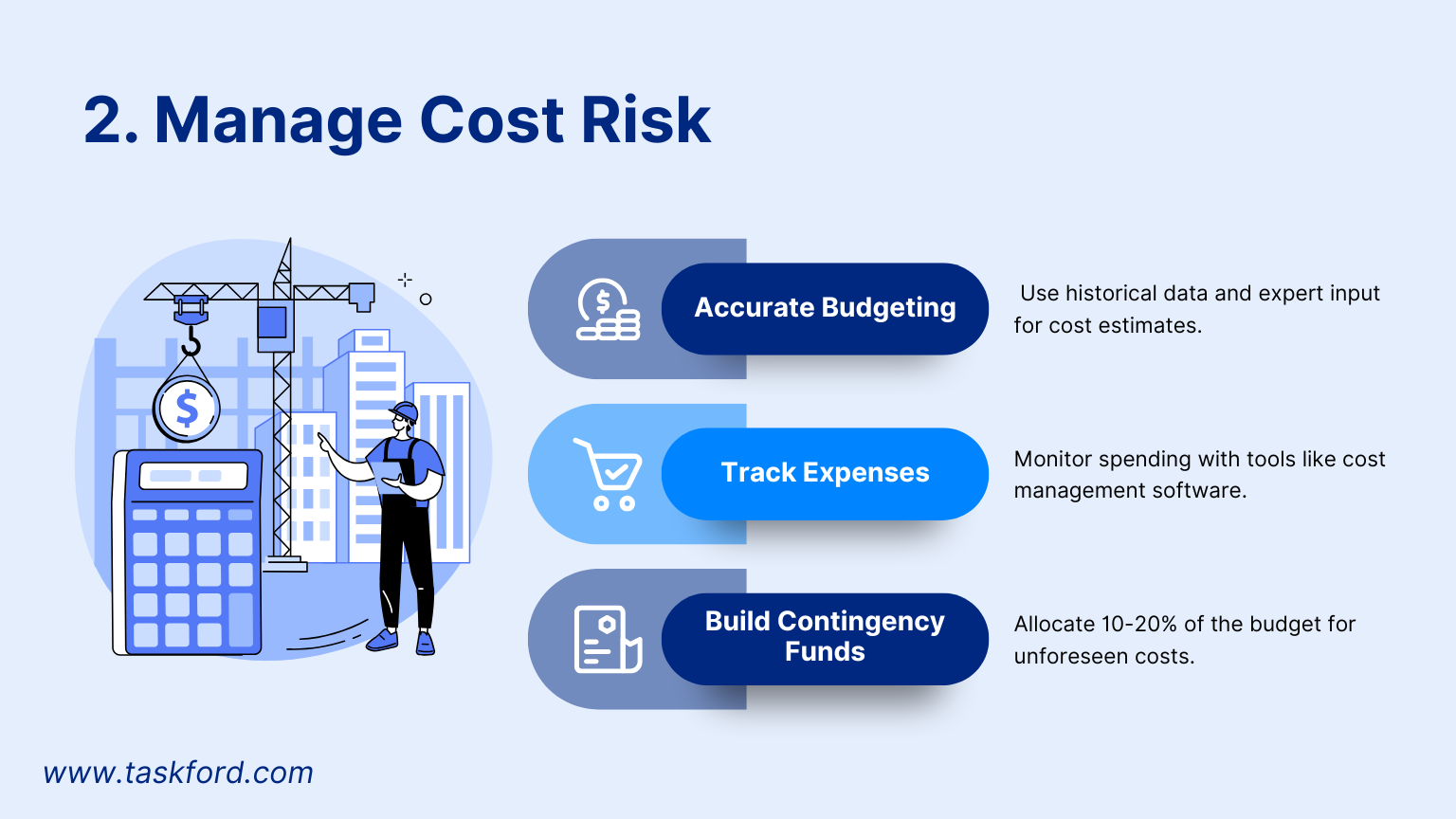
What Is Cost Risk?
Cost risk occurs when a project exceeds its allocated budget due to poor estimation, unexpected expenses, or resource mismanagement. This can strain finances and jeopardize project completion.
Example of Cost Risk
In a construction project, underestimating material costs or encountering supply chain disruptions (e.g., a sudden increase in steel prices) can push expenses beyond the budget.
How to Manage Cost Risk
- Accurate Budgeting: Use historical data and expert input for cost estimates.
- Track Expenses: Monitor spending with tools like cost management software.
- Build Contingency Funds: Allocate 10-20% of the budget for unforeseen costs.
Learn more about A Step-by-Step Guide to Effective Project Cost Management
3. Schedule Risk
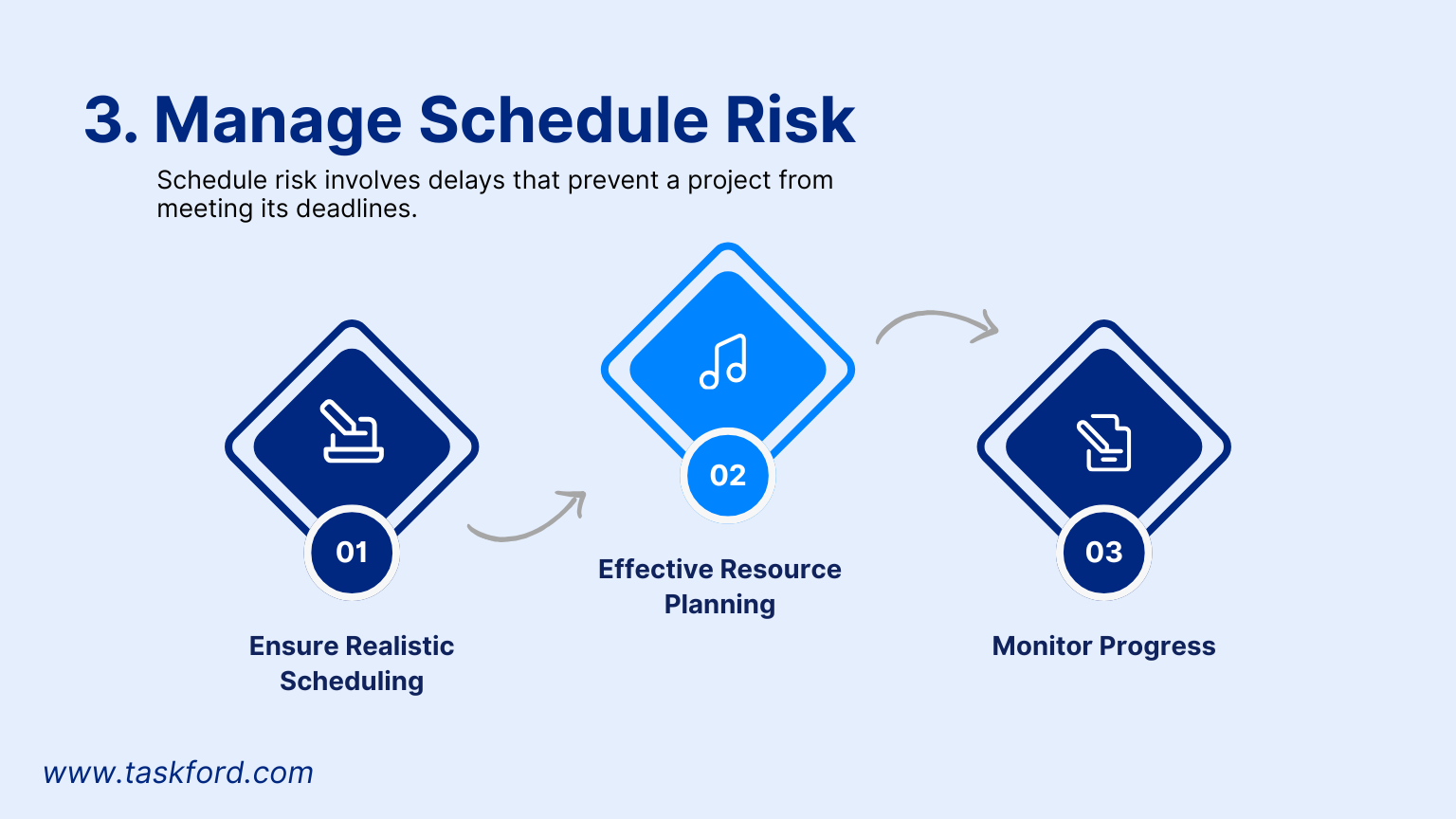
What Is Schedule Risk?
Schedule risk involves delays that prevent a project from meeting its deadlines. Causes include unrealistic timelines, resource shortages, or external dependencies.
Example of Schedule Risk
In a software development project, a key developer falling ill or a third-party vendor delaying API integration can push back the launch date.
How to Manage Schedule Risk
- Realistic Scheduling: Use techniques like Critical Path Method (CPM) to map timelines.
- Resource Planning: Ensure team availability and backup resources.
- Monitor Progress: Use Gantt charts or project management softwares to track milestones.
4. Resource Risk
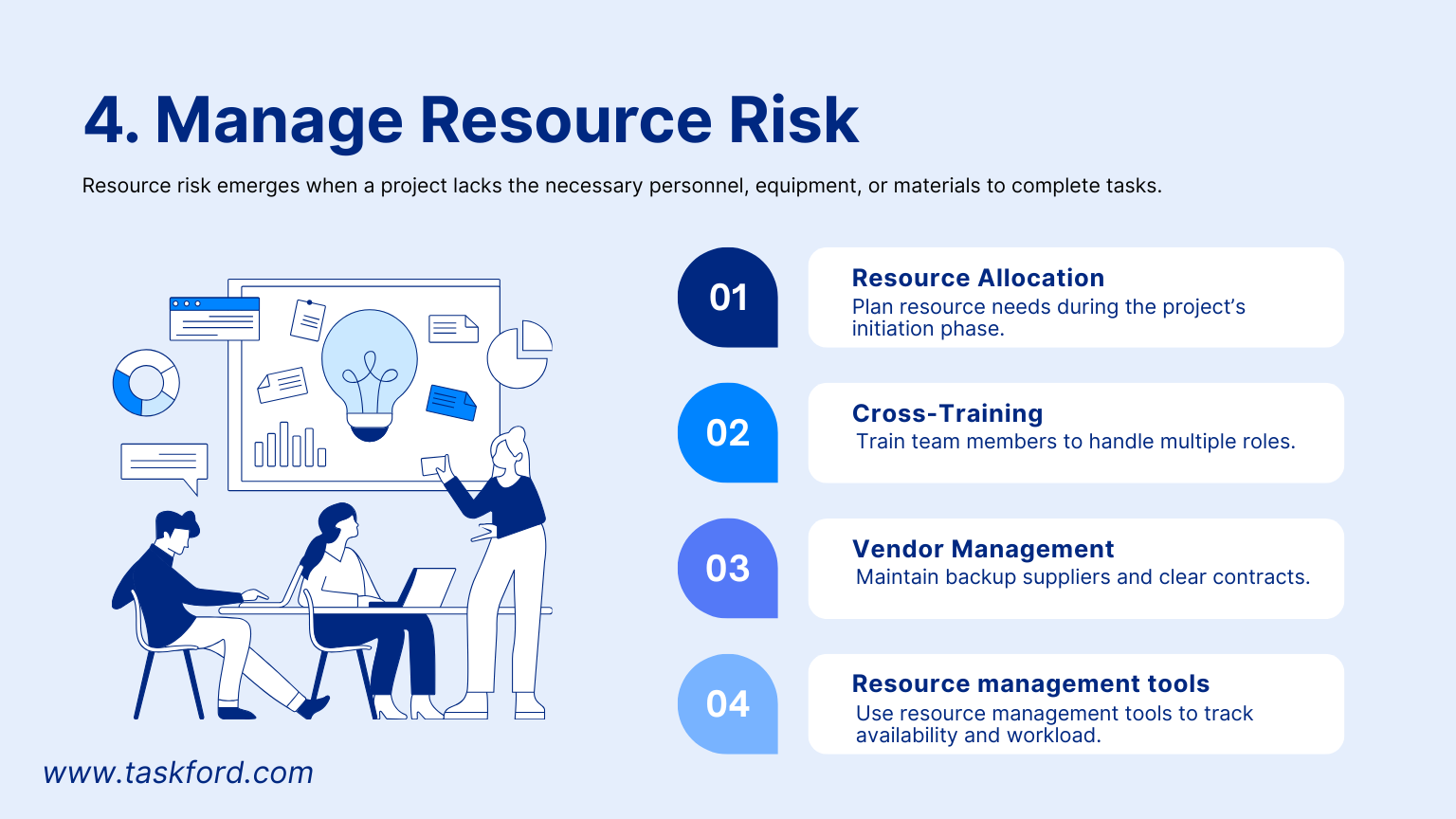
What Is Resource Risk?
Resource risk emerges when a project lacks the necessary personnel, equipment, or materials to complete tasks. This can stem from overallocation, turnover, or supply issues.
Example of Resource Risk
In an event planning project, a key vendor failing to deliver equipment on time or a team member leaving mid-project can disrupt operations.
How to Manage Resource Risk
- Resource Allocation: Plan resource needs during the project’s initiation phase.
- Cross-Training: Train team members to handle multiple roles.
- Vendor Management: Maintain backup suppliers and clear contracts.
- Use resource management tools to track availability and workload.
5. Technical Risk
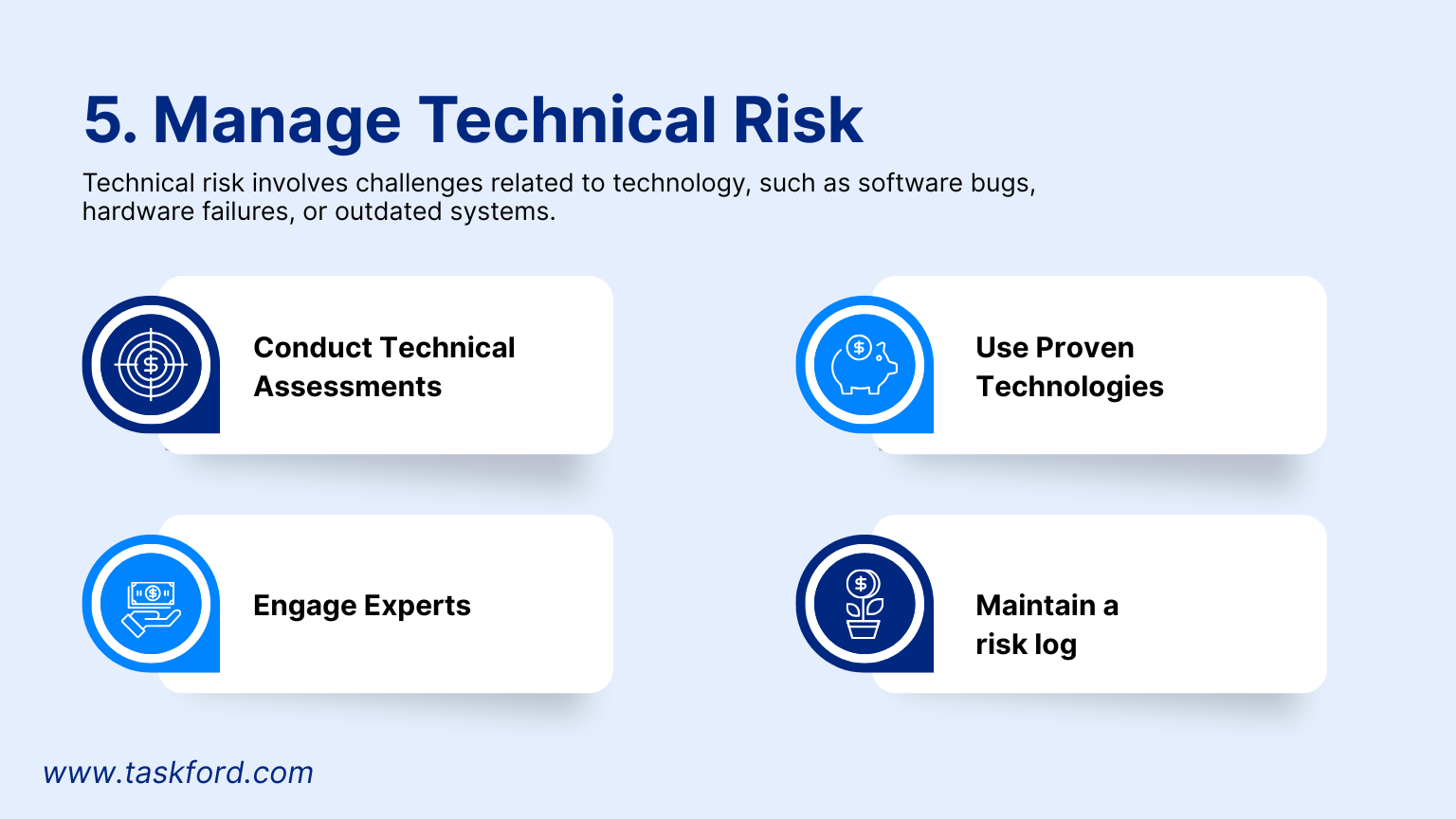
What Is Technical Risk?
Technical risk involves challenges related to technology, such as software bugs, hardware failures, or outdated systems. These risks are common in IT and engineering projects.
Example of Technical Risk
In a cloud migration project, compatibility issues between legacy systems and new platforms can cause data loss or downtime.
How to Manage Technical Risk
- Conduct Technical Assessments: Test systems before full implementation.
- Use Proven Technologies: Avoid untested tools unless necessary.
- Engage Experts: Involve specialists for complex technical tasks.
- Maintain a risk log to document and monitor technical issues.
6. Operational Risk
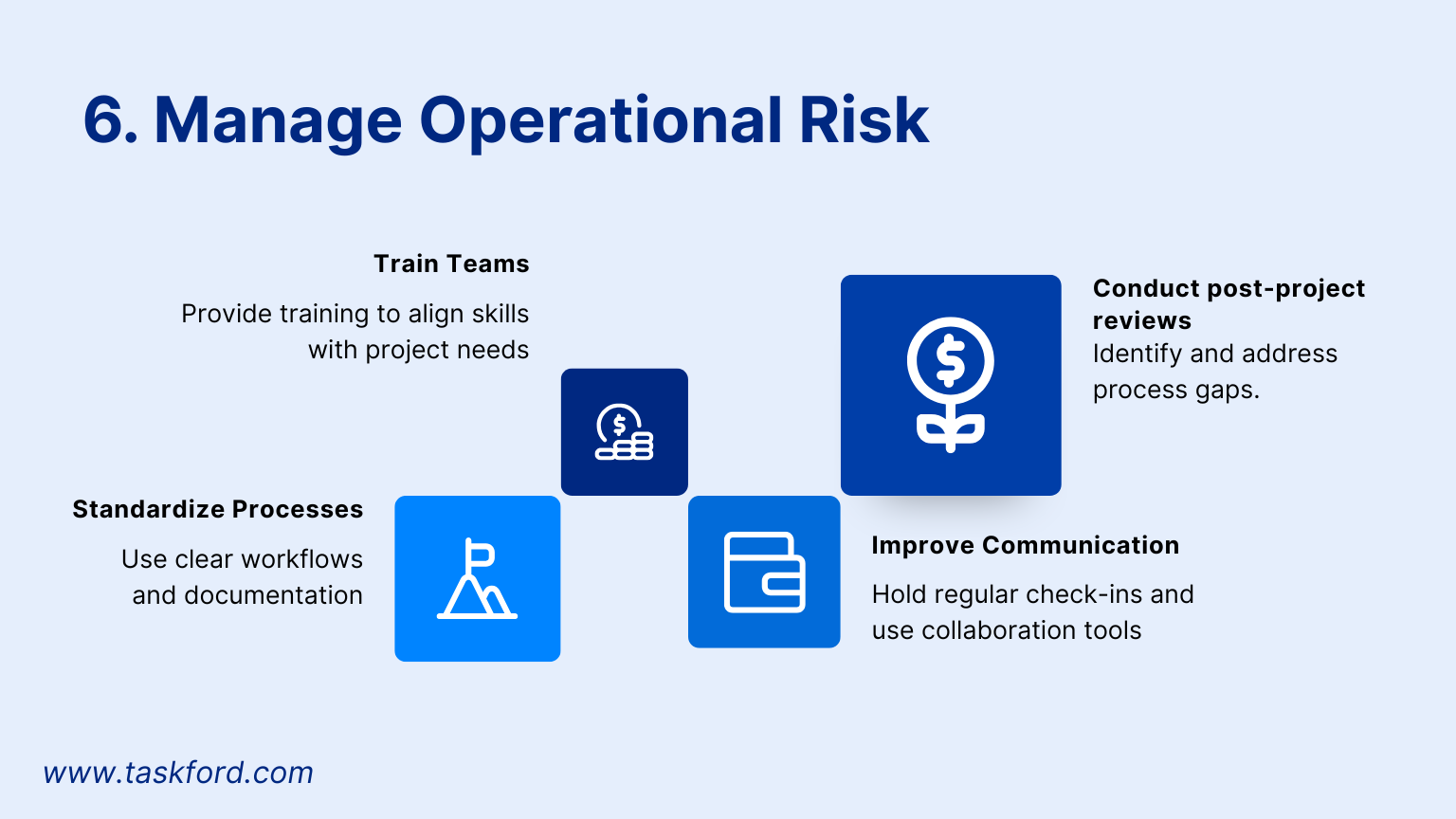
What Is Operational Risk?
Operational risk stems from internal processes, systems, or team dynamics that disrupt project execution. Examples include poor communication, inadequate training, or process failures.
Example of Operational Risk
In a marketing campaign, miscommunication between the creative and media teams can lead to mismatched deliverables, delaying the launch.
How to Manage Operational Risk
- Standardize Processes: Use clear workflows and documentation.
- Train Teams: Provide training to align skills with project needs.
- Improve Communication: Hold regular check-ins and use collaboration tools.
- Conduct post-project reviews to identify and address process gaps.
7. External Risk
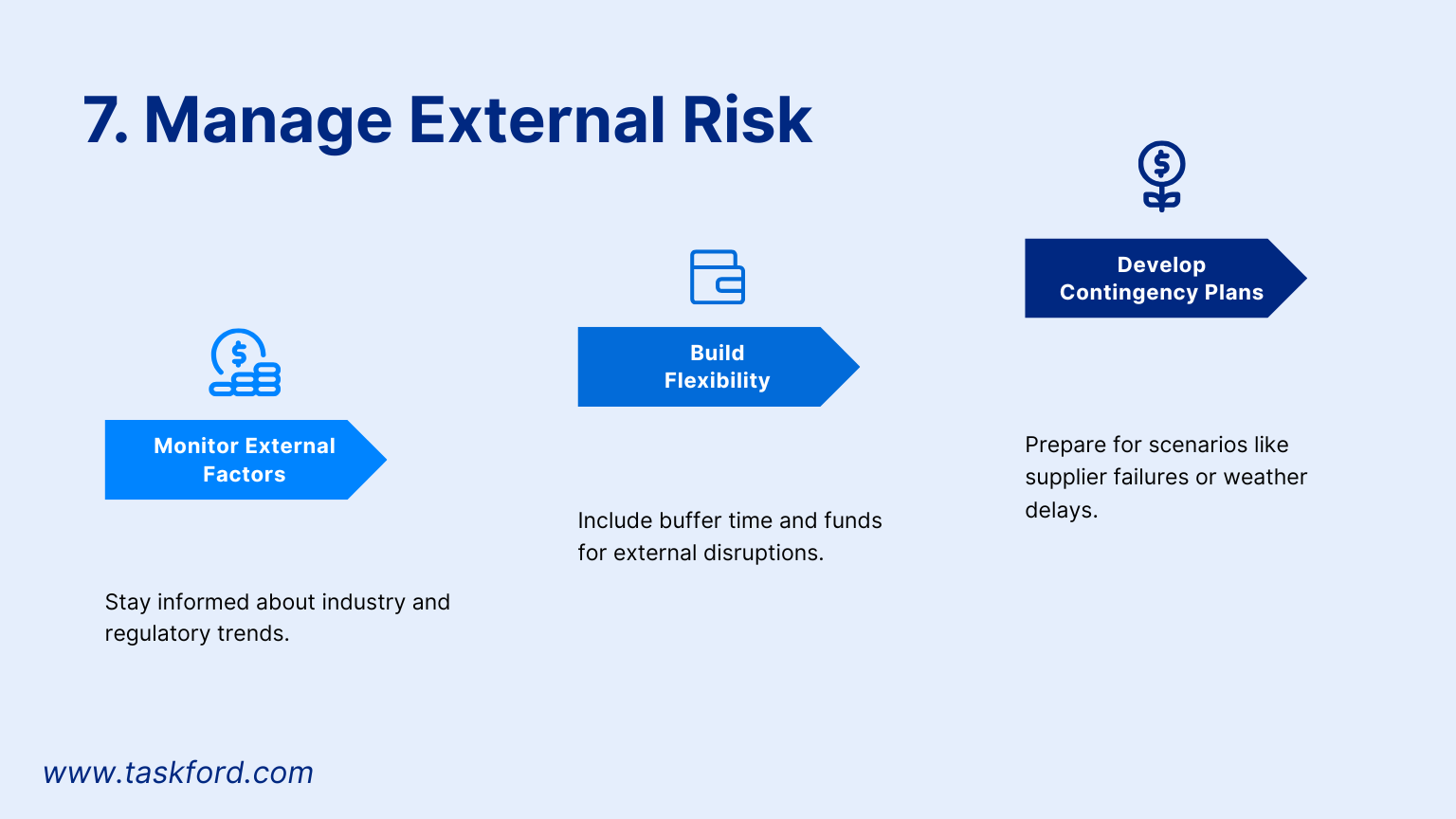
What Is External Risk?
External risks come from factors outside the project team’s control, such as regulatory changes, market shifts, or natural disasters. These risks are often unpredictable but impactful.
Example of External Risk
In a construction project, new environmental regulations may require costly design changes, or a storm could delay outdoor work.
How to Manage External Risk
- Monitor External Factors: Stay informed about industry and regulatory trends.
- Build Flexibility: Include buffer time and funds for external disruptions.
- Develop Contingency Plans: Prepare for scenarios like supplier failures or weather delays.
Why Risk Management Matters
Ignoring risks can lead to project failure, wasted resources, and damaged reputations. A proactive risk management approach ensures you’re prepared for challenges, allowing you to deliver projects on time, within budget, and to stakeholders’ satisfaction. By understanding these seven common types of risks in project management - scope, cost, schedule, resource, technical, operational, and external - you can build a robust strategy to address them.
Learn more: Enterprise Risk Management (ERM): What It Means and How It Works
Practical Tools for Risk Management
- Risk Register: A document to log risks, their likelihood, impact, and mitigation plans.
- Risk Matrix: A visual tool to prioritize risks based on severity and probability.
- Project Management Software: Tools like TaskFord help track risks, resources, and timelines in one place.
- Regular Reviews: Schedule risk assessments at key project milestones.
How to Build a Risk Management Plan
- Identify Risks: Brainstorm potential risks with your team and stakeholders.
- Assess Risks: Use a risk matrix to evaluate likelihood and impact.
- Develop Mitigation Strategies: Create specific actions for high-priority risks.
- Monitor and Update: Review the risk register regularly and adjust plans as needed.
- Communicate: Keep stakeholders informed about risks and mitigation efforts.
Conclusion
Managing risks is a core skill for any project manager. By understanding the seven common types of risk in project management - scope, cost, schedule, resource, technical, operational, and external - you can anticipate challenges and keep your projects on track. Use tools like risk registers, matrices, and project management software to stay organized and proactive. With a solid risk management plan, you’ll be better equipped to deliver successful projects, no matter the industry.
Making work simpler,
smarter, and more connected
Join our waitlist and be notified first.

Related Blog
Subscribe for Expert Tips
Unlock expert insights and stay ahead with TaskFord. Sign up now to receive valuable tips, strategies, and updates directly in your inbox.


